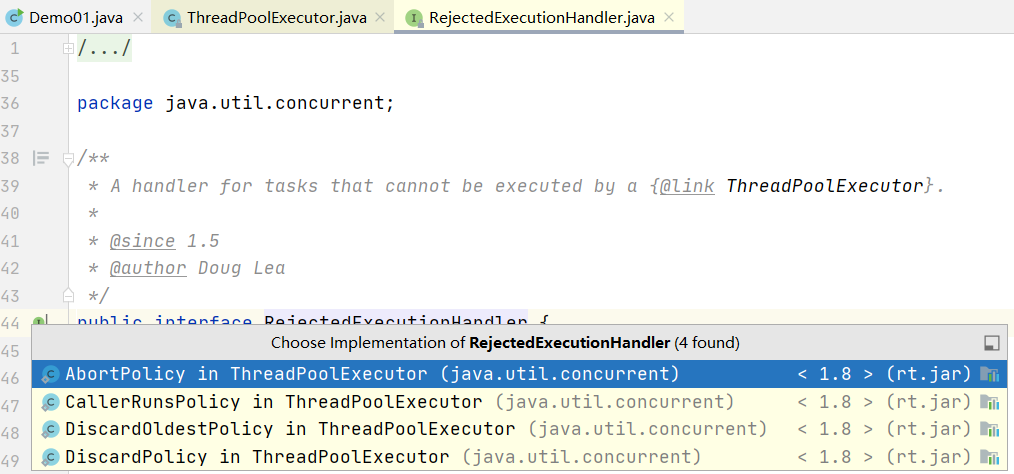JUC使用
1、什么是JUC
源码 + 官方文档 面试高频问!
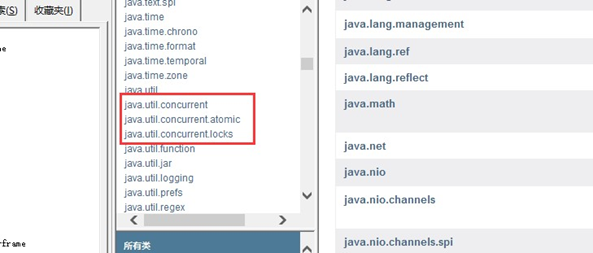
java.util 工具包、包、分类
业务:普通的线程代码 Thread
Runnable 没有返回值、效率相比入 Callable 相对较低!

2、线程和进程
进程:一个程序,QQ.exe Music.exe 程序的集合;一个进程往往可以包含多个线程,至少包含一个!
Java默认有几个线程? 2 个 mian、GC
线程:开了一个进程 Typora,写字,自动保存(线程负责的)
对于Java而言:Thread、Runnable、Callable
Java 真的可以开启线程吗? 开不了
public synchronized void start() {
/**
* This method is not invoked for the main method thread or "system"
* group threads created/set up by the VM. Any new functionality added
* to this method in the future may have to also be added to the VM.
*
* A zero status value corresponds to state "NEW".
*/
if (threadStatus != 0)
throw new IllegalThreadStateException();
/* Notify the group that this thread is about to be started
* so that it can be added to the group's list of threads
* and the group's unstarted count can be decremented. */
group.add(this);
boolean started = false;
try {
start0();
started = true;
} finally {
try {
if (!started) {
group.threadStartFailed(this);
}
} catch (Throwable ignore) {
/* do nothing. If start0 threw a Throwable then
it will be passed up the call stack */
}
}
}
// 本地方法,底层的C++ ,Java 无法直接操作硬件
private native void start0();
并发、并行
并发编程:并发、并行
并发(多线程操作同一个资源)
- CPU 一核 ,模拟出来多条线程,天下武功,唯快不破,快速交替并行(多个人一起行走)
- CUP多核,多个线程可以同时进行,线程池
public class LockTest {
public static void main(String[] args) {
System.out.println(Runtime.getRuntime().availableProcessors());
}
}
并发编程的本质:充分的利用CPU的资源。
线程有几个状态
public enum State {
/**
* 新建
*/
NEW,
/**
* 运行
*/
RUNNABLE,
/**
* 阻塞
*/
BLOCKED,
/**
* 等待,死死的等
*/
WAITING,
/**
* 超时等待
*/
TIMED_WAITING,
/**
* 终止
*/
TERMINATED;
}
wait/sleep 区别
wait => Object sleep => Thread
1、 关于锁的释放wait 会释放锁,sleep 睡觉了,抱着锁睡觉,不会释放!
2、 使用的范围是不同的
wait:必须在同步代码块中.
sleep 可以再任何地方睡
3、是否需要捕获异常 :
wait 不需要捕获异常 sleep 必须要捕获异常
3、Lock锁(重点)
传统 Synchronized
// 基本的卖票例子
import java.time.OffsetDateTime;
/**
* 真正的多线程开发,公司中的开发,降低耦合性
* 线程就是一个单独的资源类,没有任何附属的操作!
* 1、 属性、方法
*/
public class SaleTicketDemo01 {
public static void main(String[] args) {
// 并发:多线程操作同一个资源类, 把资源类丢入线程
Ticket ticket = new Ticket();
// @FunctionalInterface 函数式接口,jdk1.8 lambda表达式 (参数)->{ 代码 }
new Thread(()->{
for (int i = 1; i < 40 ; i++) {
ticket.sale();
}
},"A").start();
new Thread(()->{
for (int i = 1; i < 40 ; i++) {
ticket.sale();
}
},"B").start();
new Thread(()->{
for (int i = 1; i < 40 ; i++) {
ticket.sale();
}
},"C").start();
}
}
// 资源类 OOP
class Ticket {
// 属性、方法
private int number = 30;
// 卖票的方式
// synchronized 本质: 队列,锁
public synchronized void sale(){
if (number>0){
System.out.println(Thread.currentThread().getName()+"卖出了"+(number--)+"票,剩余:"+number);
}
}
}
Lock接口
公平锁:十分公平:可以先来后到非公平锁:十分不公平:可以插队 (默认)
public class SaleTicketDemo02 {
public static void main(String[] args) {
// 并发:多线程操作同一个资源类, 把资源类丢入线程
Ticket2 ticket = new Ticket2();
// @FunctionalInterface 函数式接口,jdk1.8 lambda表达式 (参数)->{ 代码 }
new Thread(()->{for (int i = 1; i < 40 ; i++) ticket.sale();},"A").start();
new Thread(()->{for (int i = 1; i < 40 ; i++) ticket.sale();},"B").start();
new Thread(()->{for (int i = 1; i < 40 ; i++) ticket.sale();},"C").start();
}
}
// Lock三部曲
// 1、 new ReentrantLock();
// 2、 lock.lock(); // 加锁
// 3、 finally=> lock.unlock(); // 解锁
class Ticket2 {
// 属性、方法
private int number = 30;
Lock lock = new ReentrantLock();
public void sale(){
lock.lock(); // 加锁
try {
// 业务代码
if (number>0){
System.out.println(Thread.currentThread().getName()+"卖出了"+(number--)+"票,剩余:"+number);
}
} catch (Exception e) {
e.printStackTrace();
} finally {
lock.unlock(); // 解锁
}
}
}
Synchronized 和 Lock 区别
1、 Synchronized 内置的Java关键字, Lock 是一个Java类
2、 Synchronized 无法判断获取锁的状态,Lock 可以判断是否获取到了锁
3、 Synchronized 会自动释放锁,lock 必须要手动释放锁!如果不释放锁,死锁
4、 Synchronized 线程 1(获得锁,阻塞)、线程2(等待,傻傻的等);Lock锁就不一定会等待下去;
5、 Synchronized 可重入锁,不可以中断的,非公平;Lock ,可重入锁,可以 判断锁,非公平(可以自己设置);
6、 Synchronized 适合锁少量的代码同步问题,Lock 适合锁大量的同步代码!
4、生产者和消费者问题
面试的:单例模式、排序算法、生产者和消费者、死锁
生产者和消费者问题 Synchronized版
问题存在,A B C D 4 个线程! 虚假唤醒,所以不能使用if-else,因为if只能判断一次,当第二个线程也进来的话,就不会判断了,需要改成while
结论:就是用if判断的话,唤醒后线程会从wait之后的代码开始运行,但是不会重新判断if条件,直接继续运行if代码块之后的代码,而如果使用while的话,也会从wait之后的代码运行,但是唤醒后会重新判断循环条件,如果不成立再执行while代码块之后的代码块,成立的话继续wait。

/**
* 线程之间的通信问题:生产者和消费者问题! 等待唤醒,通知唤醒
* 线程交替执行 A B 操作同一个变量 num = 0
* A num+1
* B num-1
*/
public class A {
public static void main(String[] args) {
Data data = new Data();
new Thread(()->{
for (int i = 0; i < 10; i++) {
try {
data.increment();
} catch (InterruptedException e) {
e.printStackTrace();
}
}
},"A").start();
new Thread(()->{
for (int i = 0; i < 10; i++) {
try {
data.decrement();
} catch (InterruptedException e) {
e.printStackTrace();
}
}
},"B").start();
new Thread(()->{
for (int i = 0; i < 10; i++) {
try {
data.increment();
} catch (InterruptedException e) {
e.printStackTrace();
}
}
},"C").start();
new Thread(()->{
for (int i = 0; i < 10; i++) {
try {
data.decrement();
} catch (InterruptedException e) {
e.printStackTrace();
}
}
},"D").start();
}
}
// 判断等待,业务,通知
class Data{ // 数字 资源类
private int number = 0;
//+1
public synchronized void increment() throws InterruptedException {
while (number!=0){ //0
// 等待
this.wait();
}
number++;
System.out.println(Thread.currentThread().getName()+"=>"+number);
// 通知其他线程,我+1完毕了
this.notifyAll();
}
//-1
public synchronized void decrement() throws InterruptedException {
while (number==0){ // 1
// 等待
this.wait();
}
number--;
System.out.println(Thread.currentThread().getName()+"=>"+number);
// 通知其他线程,我-1完毕了
this.notifyAll();
}
}
JUC版的生产者和消费者问题
代码实现:
public class B {
public static void main(String[] args) {
Data2 data = new Data2();
new Thread(()->{
for (int i = 0; i < 10; i++) {
try {
data.increment();
} catch (InterruptedException e) {
e.printStackTrace();
}
}
},"A").start();
new Thread(()->{
for (int i = 0; i < 10; i++) {
try {
data.decrement();
} catch (InterruptedException e) {
e.printStackTrace();
}
}
},"B").start();
new Thread(()->{
for (int i = 0; i < 10; i++) {
try {
data.increment();
} catch (InterruptedException e) {
e.printStackTrace();
}
}
},"C").start();
new Thread(()->{
for (int i = 0; i < 10; i++) {
try {
data.decrement();
} catch (InterruptedException e) {
e.printStackTrace();
}
}
},"D").start();
}
}
// 判断等待,业务,通知
class Data2{ // 数字 资源类
private int number = 0;
Lock lock = new ReentrantLock();
Condition condition = lock.newCondition();
//condition.await(); // 等待
//condition.signalAll(); // 唤醒全部
//+1
public void increment() throws InterruptedException {
lock.lock();
try {
// 业务代码
while (number!=0){ //0
// 等待
condition.await();
}
number++;
System.out.println(Thread.currentThread().getName()+"=>"+number);
// 通知其他线程,我+1完毕了
condition.signalAll();
} catch (Exception e) {
e.printStackTrace();
} finally {
lock.unlock();
}
}
//-1
public synchronized void decrement() throws InterruptedException {
lock.lock();
try {
while (number==0){ // 1
// 等待
condition.await();
}
number--;
System.out.println(Thread.currentThread().getName()+"=>"+number);
// 通知其他线程,我-1完毕了
condition.signalAll();
} catch (Exception e) {
e.printStackTrace();
} finally {
lock.unlock();
}
}
}
任何一个新的技术,绝对不是仅仅只是覆盖了原来的技术,优势和补充!
Condition 精准的通知和唤醒线程
代码测试:
/**
* A 执行完调用B,B执行完调用C,C执行完调用A
*/
public class C {
public static void main(String[] args) {
Data3 data = new Data3();
new Thread(()->{
for (int i = 0; i <10 ; i++) {
data.printA();
}
},"A").start();
new Thread(()->{
for (int i = 0; i <10 ; i++) {
data.printB();
}
},"B").start();
new Thread(()->{
for (int i = 0; i <10 ; i++) {
data.printC();
}
},"C").start();
}
}
class Data3{ // 资源类 Lock
private Lock lock = new ReentrantLock();
private Condition condition1 = lock.newCondition();
private Condition condition2 = lock.newCondition();
private Condition condition3 = lock.newCondition();
private int number = 1; // 1A 2B 3C
public void printA(){
lock.lock();
try {
// 业务,判断-> 执行-> 通知
while (number!=1){
// 等待
condition1.await();
}
System.out.println(Thread.currentThread().getName()+"=>AAAAAAA");
// 唤醒,唤醒指定的人,B
number = 2;
condition2.signal();
} catch (Exception e) {
e.printStackTrace();
} finally {
lock.unlock();
}
}
public void printB(){
lock.lock();
try {
// 业务,判断-> 执行-> 通知
while (number!=2){
condition2.await();
}
System.out.println(Thread.currentThread().getName()+"=>BBBBBBBBB");
// 唤醒,唤醒指定的人,c
number = 3;
condition3.signal();
} catch (Exception e) {
e.printStackTrace();
} finally {
lock.unlock();
}
}
public void printC(){
lock.lock();
try {
// 业务,判断-> 执行-> 通知
// 业务,判断-> 执行-> 通知
while (number!=3){
condition3.await();
}
System.out.println(Thread.currentThread().getName()+"=>BBBBBBBBB");
// 唤醒,唤醒指定的人,c
number = 1;
condition1.signal();
} catch (Exception e) {
e.printStackTrace();
} finally {
lock.unlock();
}
}
}
5、8锁现象
6、集合类不安全
List 不安全
// java.util.ConcurrentModificationException 并发修改异常!
public class ListTest {
public static void main(String[] args) {
// 并发下 ArrayList 不安全的吗,Synchronized;
/**
* 解决方案;
* 1、List<String> list = new Vector<>();
* 使用synchronized实现的
* 2、List<String> list = Collections.synchronizedList(new ArrayList<>());
* 使用synchronized实现的
* 3、List<String> list = new CopyOnWriteArrayList<>();
* CopyOnWrite 写入时复制 COW 计算机程序设计领域的一种优化策略;
*/
// 多个线程调用的时候,list,读取的时候,固定的,写入(覆盖)
// 在写入的时候避免覆盖,造成数据问题!
// 读写分离
// CopyOnWriteArrayList 比 Vector Nb 在哪里?
List<String> list = new CopyOnWriteArrayList<>();
for (int i = 1; i <= 10; i++) {
new Thread(()->{
list.add(UUID.randomUUID().toString().substring(0,5));
System.out.println(list);
},String.valueOf(i)).start();
}
}
}
Set 不安全
/**
* 同理可证 : ConcurrentModificationException
* //1、Set<String> set = Collections.synchronizedSet(new HashSet<>());
*/
public class SetTest {
public static void main(String[] args) {
// Set<String> set = new HashSet<>();
// hashmap
// Set<String> set = Collections.synchronizedSet(new HashSet<>());
Set<String> set = new CopyOnWriteArraySet<>();
for (int i = 1; i <=30 ; i++) {
new Thread(()->{
set.add(UUID.randomUUID().toString().substring(0,5));
System.out.println(set);
},String.valueOf(i)).start();
}
}
}
Map 不安全
map底层源码
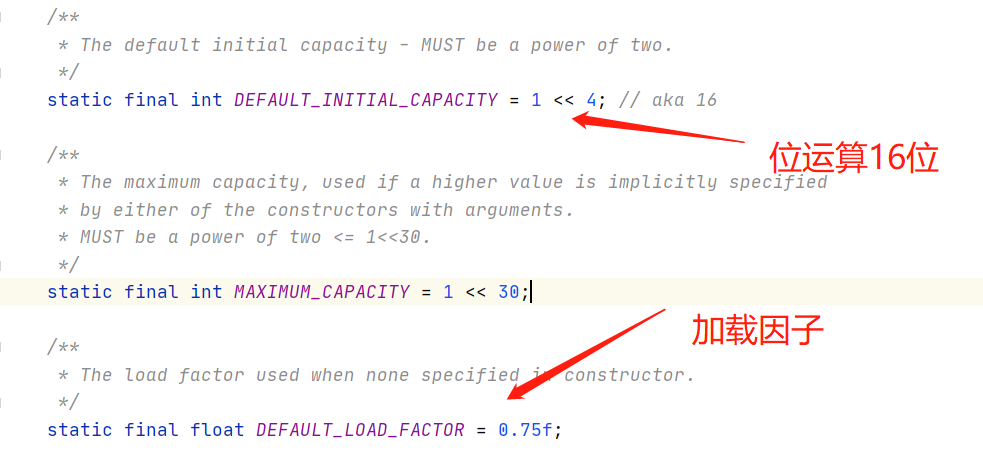
// ConcurrentModificationException
public class MapTest {
public static void main(String[] args) {
// map 是这样用的吗? 不是,工作中不用 HashMap
// 默认等价于什么? new HashMap<>(16,0.75);
// Map<String, String> map = new HashMap<>();
// 唯一的一个家庭作业:研究ConcurrentHashMap的原理
Map<String, String> map = new ConcurrentHashMap<>();
for (int i = 1; i <=30; i++) {
new Thread(()->{
map.put(Thread.currentThread().getName(),UUID.randomUUID().toString().substring(0,5));
System.out.println(map);
},String.valueOf(i)).start();
}
}
}
7、Callable ( 简单 )

该方法创建线程和Runnable有什么区别呢?
1、 可以有返回值
2、 可以抛出异常
3、 方法不同,run()/ call()
/**
* 1、探究原理
* 2、觉自己会用
*/
public class CallableTest {
public static void main(String[] args) throws ExecutionException, InterruptedException {
// new Thread(new Runnable()).start();
// new Thread(new FutureTask<V>()).start();
// new Thread(new FutureTask<V>( Callable )).start();
new Thread().start(); // 怎么启动Callable
MyThread thread = new MyThread();
FutureTask futureTask = new FutureTask(thread); // 适配类
new Thread(futureTask,"A").start();
new Thread(futureTask,"B").start(); // 结果会被缓存,效率高
Integer o = (Integer) futureTask.get(); //这个get方法是获取返回值,但是可能会产生阻塞!所以把他放到最后
// 或者使用异步通信来处理!
System.out.println(o);
}
}
class MyThread implements Callable<Integer> {
@Override
public Integer call() {
System.out.println("call()"); // 会打印几个call
// 耗时的操作
return 1024;
}
}
细节:
1、 有缓存
2、 结果可能需要等待,会阻塞!
8、常用的辅助类(必会)
8.1、CountDownLatch

// 计数器
public class CountDownLatchDemo {
public static void main(String[] args) throws InterruptedException {
// 总数是6,必须要执行任务的时候,再使用!
CountDownLatch countDownLatch = new CountDownLatch(6);
for (int i = 1; i <=6 ; i++) {
new Thread(()->{
System.out.println(Thread.currentThread().getName()+" Go out");
countDownLatch.countDown(); // 数量-1
},String.valueOf(i)).start();
}
countDownLatch.await(); // 等待计数器归零,然后再向下执行
System.out.println("Close Door");
}
}
原理:每次有线程调用 countDown() 数量-1,假设计数器变为0,countDownLatch.await() 就会被唤醒,继续执行!
8.2、CyclicBarrier

加法计数器:需要两个参数,一个是要到达的值,一个是要执行的内容。
public class CyclicBarrierDemo {
public static void main(String[] args) {
/**
* 集齐7颗龙珠召唤神龙
*/
// 召唤龙珠的线程
CyclicBarrier cyclicBarrier = new CyclicBarrier(8,()->{
System.out.println("召唤神龙成功!");
});
for (int i = 1; i <=8 ; i++) {
final int temp = i;
// lambda能操作到 i 吗
new Thread(()->{
System.out.println(Thread.currentThread().getName()+"收集"+temp+"个龙珠");
try {
cyclicBarrier.await(); // 等待
} catch (InterruptedException e) {
e.printStackTrace();
} catch (BrokenBarrierException e) {
e.printStackTrace();
}
}).start();
}
}
}
8.3、Semaphore
Semaphore:信号量
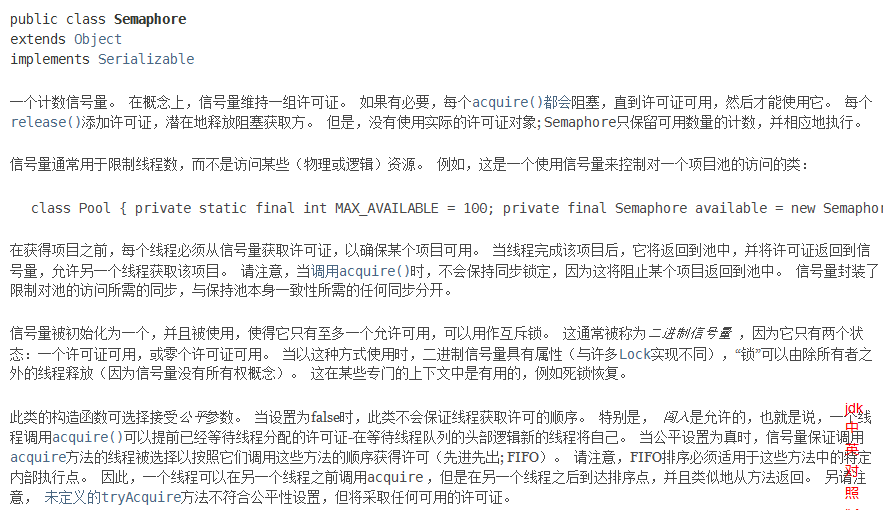
抢车位!
6车---3个停车位置
public class SemaphoreDemo {
public static void main(String[] args) {
// 线程数量:停车位! 限流!
Semaphore semaphore = new Semaphore(3);
for (int i = 1; i <=6 ; i++) {
new Thread(()->{
// acquire() 得到
try {
semaphore.acquire();
System.out.println(Thread.currentThread().getName()+"抢到车位");
TimeUnit.SECONDS.sleep(2);
System.out.println(Thread.currentThread().getName()+"离开车位");
} catch (InterruptedException e) {
e.printStackTrace();
} finally {
semaphore.release(); // release() 释放
}
},String.valueOf(i)).start();
}
}
}
原理:假设如果已经满了,等待,等待被释放为止! semaphore.release(); 释放,会将当前的信号量释放 + 1,然后唤醒等待的线程!作用: 多个共享资源互斥的使用!并发限流,控制 大的线程数!
9、阻塞队列
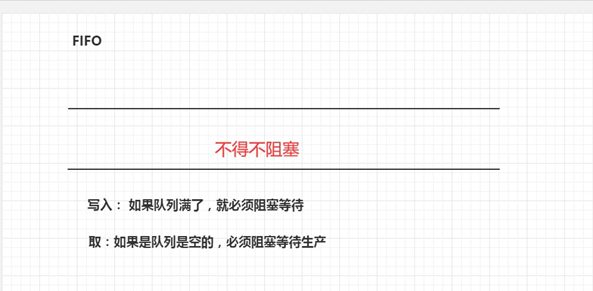
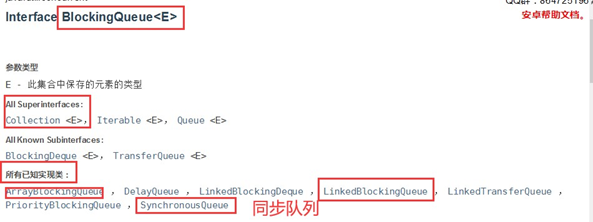
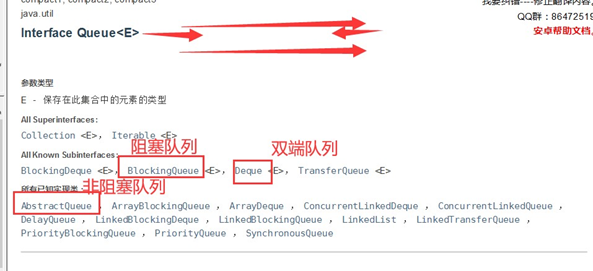
BlockingQueue BlockingQueue 不是新的东西,是之前就有的

什么情况下我们会使用 阻塞队列:多线程并发处理,线程池!学会使用队列添加、移除四组API
| 方式 | 抛出异常 | 有返回值,不抛出异常 | 阻塞 等待 | 超时等待 |
|---|---|---|---|---|
| 添加 | add | offer() | put() | offer(,,) |
| 移除 | remove | poll() | take() | poll(,) |
| 检测队首元素 | element | peek | - | - |
public class Test {
public static void main(String[] args) throws InterruptedException {
test4();
}
/**
* 添加不上去就抛出异常
*/
public static void test1(){
// 队列的大小
ArrayBlockingQueue blockingQueue = new ArrayBlockingQueue<>(3);
System.out.println(blockingQueue.add("a"));
System.out.println(blockingQueue.add("b"));
System.out.println(blockingQueue.add("c"));
// IllegalStateException: Queue full 抛出异常!
// System.out.println(blockingQueue.add("d"));
System.out.println("=-===========");
System.out.println(blockingQueue.element()); // 查看队首元素是谁
System.out.println(blockingQueue.remove()); // remove方法移除队首元素
System.out.println(blockingQueue.remove());
System.out.println(blockingQueue.remove());
// java.util.NoSuchElementException 抛出异常!
// System.out.println(blockingQueue.remove());
}
/**
* 有返回值,没有异常
*/
public static void test2(){
// 队列的大小
ArrayBlockingQueue blockingQueue = new ArrayBlockingQueue<>(3);
System.out.println(blockingQueue.offer("a"));
System.out.println(blockingQueue.offer("b"));
System.out.println(blockingQueue.offer("c"));
System.out.println(blockingQueue.peek());
// System.out.println(blockingQueue.offer("d")); // false 不抛出异常!
System.out.println("============================");
System.out.println(blockingQueue.poll());
System.out.println(blockingQueue.poll());
System.out.println(blockingQueue.poll());
System.out.println(blockingQueue.poll()); // null 不抛出异常!
}
/**
* 等待,阻塞(一直阻塞)
*/
public static void test3() throws InterruptedException {
// 队列的大小
ArrayBlockingQueue blockingQueue = new ArrayBlockingQueue<>(3);
// 一直阻塞
blockingQueue.put("a");
blockingQueue.put("b");
blockingQueue.put("c");
// blockingQueue.put("d"); // 队列没有位置了,一直阻塞
System.out.println(blockingQueue.take());
System.out.println(blockingQueue.take());
System.out.println(blockingQueue.take());
System.out.println(blockingQueue.take()); // 没有这个元素,一直阻塞
}
/**
* 等待,阻塞(等待超时)
*/
public static void test4() throws InterruptedException {
// 队列的大小
ArrayBlockingQueue blockingQueue = new ArrayBlockingQueue<>(3);
blockingQueue.offer("a");
blockingQueue.offer("b");
blockingQueue.offer("c");
// blockingQueue.offer("d",2,TimeUnit.SECONDS); // 等待超过2秒就退出
System.out.println("===============");
System.out.println(blockingQueue.poll());
System.out.println(blockingQueue.poll());
System.out.println(blockingQueue.poll());
blockingQueue.poll(2,TimeUnit.SECONDS); // 等待超过2秒就退出
}
}
SynchronousQueue 同步队列
没有容量,进去一个元素,必须等待取出来之后,才能再往里面放一个元素!
put、take
/**
* 同步队列
* 和其他的BlockingQueue 不一样, SynchronousQueue 不存储元素
* put了一个元素,必须从里面先take取出来,否则不能在put进去值!
*/
public class SynchronousQueueDemo {
public static void main(String[] args) {
BlockingQueue<String> blockingQueue = new SynchronousQueue<>(); // 同步队列
new Thread(()->{
try {
System.out.println(Thread.currentThread().getName()+" put 1");
blockingQueue.put("1");
System.out.println(Thread.currentThread().getName()+" put 2");
blockingQueue.put("2");
System.out.println(Thread.currentThread().getName()+" put 3");
blockingQueue.put("3");
//添加多个不报错
blockingQueue.put("4");
blockingQueue.put("5");
} catch (InterruptedException e) {
e.printStackTrace();
}
},"T1").start();
new Thread(()->{
try {
TimeUnit.SECONDS.sleep(3);
System.out.println(Thread.currentThread().getName()+"=>"+blockingQueue.take());
TimeUnit.SECONDS.sleep(3);
System.out.println(Thread.currentThread().getName()+"=>"+blockingQueue.take());
TimeUnit.SECONDS.sleep(3);
System.out.println(Thread.currentThread().getName()+"=>"+blockingQueue.take());
//取空的值不报错
// System.out.println(Thread.currentThread().getName()+"取空的值=>"+blockingQueue.take());
} catch (InterruptedException e) {
e.printStackTrace();
}
},"T2").start();
}
}
10、线程池(重点)
线程池:三大方法、7大参数、4种拒绝策略
池化技术
程序的运行,本质:占用系统的资源! 优化资源的使用!=>池化技术线程池、连接池、内存池、对象池///..... 创建、销毁。十分浪费资源
池化技术:事先准备好一些资源,有人要用,就来我这里拿,用完之后还给我。
线程池的好处:
1、 降低资源的消耗
2、 提高响应的速度
3、 方便管理。
线程复用、可以控制最大并发数、管理线程
线程池:三大方法
// Executors 工具类、3大方法
public class Demo02 {
public static void main(String[] args) {
//单个线程
// ExecutorService threadPool = Executors.newSingleThreadExecutor();
//创建一个固定的线程池大小
// ExecutorService threadPool = Executors.newFixedThreadPool(5);
//可伸缩的线程池,遇强则强,遇弱则弱
ExecutorService threadPool = Executors.newCachedThreadPool();
try {
// 最大承载:Deque + max
// 超过 RejectedExecutionException
for (int i = 1; i <= 25; i++) {
// 使用了线程池之后,使用线程池来创建线程
threadPool.execute(()->{
System.out.println(Thread.currentThread().getName()+" ok");
});
}
} catch (Exception e) {
e.printStackTrace();
} finally {
// 线程池用完,程序结束,关闭线程池
threadPool.shutdown();
}
}
}
7大参数
源码分析:
public static ExecutorService newSingleThreadExecutor() {
return new FinalizableDelegatedExecutorService
(new ThreadPoolExecutor(1, 1,
0L, TimeUnit.MILLISECONDS,
new LinkedBlockingQueue<Runnable>()));
}
public static ExecutorService newFixedThreadPool(int nThreads) {
return new ThreadPoolExecutor(nThreads, nThreads,
0L, TimeUnit.MILLISECONDS,
new LinkedBlockingQueue<Runnable>());
}
public static ExecutorService newCachedThreadPool() {
return new ThreadPoolExecutor(0, Integer.MAX_VALUE,
60L, TimeUnit.SECONDS,
new SynchronousQueue<Runnable>());
}
//ThreadPoolExecutor源码分析
public ThreadPoolExecutor(int corePoolSize, //核心线程池大小
int maximumPoolSize,//最大核心线程池大小
long keepAliveTime,//超时了没有人调用就会释放
TimeUnit unit,//超时单位
BlockingQueue<Runnable> workQueue,//阻塞队列
ThreadFactory threadFactory,//线程工厂,一般不用动
RejectedExecutionHandler handler //拒绝策略) {
if (corePoolSize < 0 ||
maximumPoolSize <= 0 ||
maximumPoolSize < corePoolSize ||
keepAliveTime < 0)
throw new IllegalArgumentException();
if (workQueue == null || threadFactory == null || handler == null)
throw new NullPointerException();
this.corePoolSize = corePoolSize;
this.maximumPoolSize = maximumPoolSize;
this.workQueue = workQueue;
this.keepAliveTime = unit.toNanos(keepAliveTime);
this.threadFactory = threadFactory;
this.handler = handler;
}
手动创建一个线程池
// Executors 工具类、3大方法
/**
* new ThreadPoolExecutor.AbortPolicy() // 银行满了,还有人进来,不处理这个人的,抛出异常
* new ThreadPoolExecutor.CallerRunsPolicy() // 哪来的去哪里!
* new ThreadPoolExecutor.DiscardPolicy() //队列满了,丢掉任务,不会抛出异常!
* new ThreadPoolExecutor.DiscardOldestPolicy() //队列满了,尝试去和最早的竞争,也不会抛出异常!
*/
public class Demo01 {
public static void main(String[] args) {
// 自定义线程池!工作 ThreadPoolExecutor
// 最大线程到底该如何定义
// 1、CPU 密集型,几核,就是几,可以保持CPu的效率最高!
// 2、IO 密集型 > 判断你程序中十分耗IO的线程,
// 程序 15个大型任务 io十分占用资源!
// 获取CPU的核数
System.out.println(Runtime.getRuntime().availableProcessors());
List list = new ArrayList();
ExecutorService threadPool = new ThreadPoolExecutor(
2,
Runtime.getRuntime().availableProcessors(),
3,
TimeUnit.SECONDS,
new LinkedBlockingDeque<>(3),
Executors.defaultThreadFactory(),
new ThreadPoolExecutor.DiscardOldestPolicy()); //队列满了,尝试去和最早的竞争,也不会抛出异常!
try {
// 最大承载:Deque + max 队列的值+最大承载的值
// 超过 RejectedExecutionException
for (int i = 1; i <= 9; i++) {
// 使用了线程池之后,使用线程池来创建线程
threadPool.execute(()->{
System.out.println(Thread.currentThread().getName()+" ok");
});
}
} catch (Exception e) {
e.printStackTrace();
} finally {
// 线程池用完,程序结束,关闭线程池
threadPool.shutdown();
}
}
}
4种拒绝策略
/**
* new ThreadPoolExecutor.AbortPolicy() // 银行满了,还有人进来,不处理这个人的,抛出异常
* new ThreadPoolExecutor.CallerRunsPolicy() // 哪来的去哪里!
* new ThreadPoolExecutor.DiscardPolicy() //队列满了,丢掉任务,不会抛出异常!
* new ThreadPoolExecutor.DiscardOldestPolicy() //队列满了,尝试去和最早的竞争,也不会抛出异常!
*/
小结和拓展
池的 大的大小如何去设置!
了解:IO密集型,CPU密集型:(调优)
// 1、CPU 密集型,几核,就是几,可以保持CPu的效率最高!
// 2、IO 密集型 > 判断你程序中十分耗IO的线程,
// 程序 15个大型任务 io十分占用资源!
11、四大函数式接口(必需掌握)
新时代的程序员:lambda表达式、链式编程、函数式接口、Stream流式计算
函数式接口: 只有一个方法的接口
@FunctionalInterface
public interface Runnable {
/**
* When an object implementing interface <code>Runnable</code> is used
* to create a thread, starting the thread causes the object's
* <code>run</code> method to be called in that separately executing
* thread.
* <p>
* The general contract of the method <code>run</code> is that it may
* take any action whatsoever.
*
* @see java.lang.Thread#run()
*/
public abstract void run();
}

Function函数式接口
/**
* Function 函数型接口, 有一个输入参数,有一个输出
* 只要是 函数型接口 可以 用 lambda表达式简化
*/
public class Demo01 {
public static void main(String[] args) {
//
// Function<String,String> function = new Function<String,String>() {
// @Override
// public String apply(String str) {
// return str;
// }
// };
Function<String,String> function = str->{return str;};
System.out.println(function.apply("asd"));
}
}
断定型接口:有一个输入参数,返回值只能是 布尔值!
/**
* 断定型接口:有一个输入参数,返回值只能是 布尔值!
*/
public class Demo02 {
public static void main(String[] args) {
// 判断字符串是否为空
// Predicate<String> predicate = new Predicate<String>(){
//// @Override
//// public boolean test(String str) {
//// return str.isEmpty();
//// }
//// };
Predicate<String> predicate = (str)->{return str.isEmpty(); };
System.out.println(predicate.test(""));
}
}
Consumer 消费型接口
/**
* Consumer 消费型接口: 只有输入,没有返回值
*/
public class Demo03 {
public static void main(String[] args) {
// Consumer<String> consumer = new Consumer<String>() {
// @Override
// public void accept(String str) {
// System.out.println(str);
// }
// };
Consumer<String> consumer = (str)->{System.out.println(str);};
consumer.accept("sdadasd");
}
}
Supplier 供给型接口
/**
* Supplier 供给型接口 没有参数,只有返回值
*/
public class Demo04 {
public static void main(String[] args) {
// Supplier supplier = new Supplier<Integer>() {
// @Override
// public Integer get() {
// System.out.println("get()");
// return 1024;
// }
// };
Supplier supplier = ()->{ return 1024; };
System.out.println(supplier.get());
}
}
12、Stream流式计算
什么是Stream流式计算
大数据:存储 + 计算
集合、MySQL 本质就是存储东西的;计算都应该交给流来操作!
/**
* 题目要求:一分钟内完成此题,只能用一行代码实现!
* 现在有5个用户!筛选:
* 1、ID 必须是偶数
* 2、年龄必须大于23岁
* 3、用户名转为大写字母
* 4、用户名字母倒着排序
* 5、只输出一个用户!
*/
public class Test {
public static void main(String[] args) {
User u1 = new User(1,"a",21);
User u2 = new User(2,"b",22);
User u3 = new User(3,"c",23);
User u4 = new User(4,"d",24);
User u5 = new User(6,"e",25);
// 集合就是存储
List<User> list = Arrays.asList(u1, u2, u3, u4, u5);
// 计算交给Stream流
// lambda表达式、链式编程、函数式接口、Stream流式计算
list.stream()
.filter(u->{return u.getId()%2==0;})
.filter(u->{return u.getAge()>23;})
.map(u->{return u.getName().toUpperCase();})
.sorted((uu1,uu2)->{return uu2.compareTo(uu1);})
.limit(1)
.forEach(System.out::println);
}
}
13、ForkJoin
什么是 ForkJoin
ForkJoin 在 JDK 1.7出现, 并行执行任务!提高效率。大数据量!大数据:Map Reduce (把大任务拆分为小任务)
ForkJoin 特点:工作窃取
这个里面维护的都是双端队列
/**
* 求和计算的任务!
* 3000 6000(ForkJoin) 9000(Stream并行流)
* // 如何使用 forkjoin
* // 1、forkjoinPool 通过它来执行
* // 2、计算任务 forkjoinPool.execute(ForkJoinTask task)
* // 3. 计算类要继承 ForkJoinTask
*/
public class ForkJoinDemo extends RecursiveTask<Long> {
private Long start; // 1
private Long end; // 1990900000
// 临界值
private Long temp=10000l;
public ForkJoinDemo(Long start, Long end) {
this.start = start;
this.end = end;
// this.temp= (start + end) / 2;
}
// 计算方法
@Override
protected Long compute() {
if ((end-start)<temp){
Long sum = 0L;
for (Long i = start; i <= end; i++) {
sum += i;
}
return sum;
}else { // forkjoin 递归
long middle = (start + end) / 2; // 中间值
ForkJoinDemo task1 = new ForkJoinDemo(start, middle);
task1.fork(); // 拆分任务,把任务压入线程队列
ForkJoinDemo task2 = new ForkJoinDemo(middle+1, end);
task2.fork(); // 拆分任务,把任务压入线程队列
return task1.join() + task2.join();
}
}
}
测试:
public class Test {
public static void main(String[] args) throws ExecutionException, InterruptedException {
// test1(); // 7185
// test2(); // 10038
test3(); // 153
}
// 普通程序员
public static void test1(){
Long sum = 0L;
long start = System.currentTimeMillis();
for (Long i = 1L; i <= 10_0000_0000; i++) {
sum += i;
}
long end = System.currentTimeMillis();
System.out.println("sum="+sum+" 时间:"+(end-start));
}
// 会使用ForkJoin
public static void test2() throws ExecutionException, InterruptedException {
long start = System.currentTimeMillis();
ForkJoinPool forkJoinPool = new ForkJoinPool();
ForkJoinTask<Long> task = new ForkJoinDemo(0L, 10_0000_0000L);
ForkJoinTask<Long> submit = forkJoinPool.submit(task);// 提交任务
Long sum = submit.get();
long end = System.currentTimeMillis();
System.out.println("sum="+sum+" 时间:"+(end-start));
}
public static void test3(){
long start = System.currentTimeMillis();
// Stream并行流 () (]
long sum = LongStream.rangeClosed(0L, 10_0000_0000L).parallel().reduce(0, (a,b)->{return a+b;});
long end = System.currentTimeMillis();
System.out.println("sum="+sum+"时间:"+(end-start));
}
}
14、异步回调
15、JMM
请你谈谈你对 Volatile 的理解
Volatile 是 Java 虚拟机提供轻量级的同步机制
1、 保证可见性
2、 不保证原子性
3、 禁止指令重排
什么是JMM
JMM : Java内存模型,不存在的东西,概念!约定!
关于JMM的一些同步的约定:
1、 线程解锁前,必须把共享变量立刻刷回主存。
2、 线程加锁前,必须读取主存中的 新值到工作内存中!
3、 加锁和解锁是同一把锁
线程 工作内存 、主内存
内存交互操作有8种,虚拟机实现必须保证每一个操作都是原子的,不可在分的(对于double和long类型的变量来说,load、store、read和write操作在某些平台上允许例外)lock (锁定):作用于主内存的变量,把一个变量标识为线程独占状态 unlock (解锁):作用于主内存的变量,它把一个处于锁定状态的变量释放出来,释放后的变量才可以被其他线程锁定
read (读取):作用于主内存变量,它把一个变量的值从主内存传输到线程的工作内存中,以便随后的load动作使用 load (载入):作用于工作内存的变量,它把read操作从主存中变量放入工作内存中 use (使用):作用于工作内存中的变量,它把工作内存中的变量传输给执行引擎,每当虚拟机遇到一个需要使用到变量的值,就会使用到这个指令 assign (赋值):作用于工作内存中的变量,它把一个从执行引擎中接受到的值放入工作内存的变量副本中
store (存储):作用于主内存中的变量,它把一个从工作内存中一个变量的值传送到主内存中,以便后续的write使用
write (写入):作用于主内存中的变量,它把store操作从工作内存中得到的变量的值放入主内存的变量中
16、彻底玩转单例模式
饿汉式 DCL懒汉式,深究!
饿汉式
// 饿汉式单例
public class Hungry {
// 可能会浪费空间
private byte[] data1 = new byte[1024*1024];
private byte[] data2 = new byte[1024*1024];
private byte[] data3 = new byte[1024*1024];
private byte[] data4 = new byte[1024*1024];
private Hungry(){
}
private final static Hungry HUNGRY = new Hungry();
public static Hungry getInstance(){
return HUNGRY;
}
}
DCL 懒汉式
// 懒汉式单例
// 道高一尺,魔高一丈!
public class LazyMan {
private static boolean qinjiang = false;
private LazyMan(){
synchronized (LazyMan.class){
if (qinjiang == false){
qinjiang = true;
}else {
throw new RuntimeException("不要试图使用反射破坏异常");
}
}
}
private volatile static LazyMan lazyMan;
// 双重检测锁模式的 懒汉式单例 DCL懒汉式
public static LazyMan getInstance(){
if (lazyMan==null){
synchronized (LazyMan.class){
if (lazyMan==null){
lazyMan = new LazyMan(); // 不是一个原子性操作
}
}
}
return lazyMan;
}
// 反射!
public static void main(String[] args) throws Exception {
// LazyMan instance = LazyMan.getInstance();
Field qinjiang = LazyMan.class.getDeclaredField("qinjiang");
qinjiang.setAccessible(true);
Constructor<LazyMan> declaredConstructor = LazyMan.class.getDeclaredConstructor(null);
declaredConstructor.setAccessible(true);
LazyMan instance = declaredConstructor.newInstance();
qinjiang.set(instance,false);
LazyMan instance2 = declaredConstructor.newInstance();
System.out.println(instance);
System.out.println(instance2);
}
}
静态内部类
// 静态内部类
public class Holder {
private Holder(){
}
public static Holder getInstace(){
return InnerClass.HOLDER;
}
public static class InnerClass{
private static final Holder HOLDER = new Holder();
}
}
枚举
// enum 是一个什么? 本身也是一个Class类
public enum EnumSingle {
INSTANCE;
public EnumSingle getInstance(){
return INSTANCE;
}
}
class Test{
public static void main(String[] args) throws NoSuchMethodException, IllegalAccessException, InvocationTargetException, InstantiationException {
EnumSingle instance1 = EnumSingle.INSTANCE;
Constructor<EnumSingle> declaredConstructor = EnumSingle.class.getDeclaredConstructor(String.class,int.class);
declaredConstructor.setAccessible(true);
EnumSingle instance2 = declaredConstructor.newInstance();
// NoSuchMethodException: com.kuang.single.EnumSingle.<init>()
System.out.println(instance1);
System.out.println(instance2);
}
}
JUC使用的更多相关文章
- Java多线程系列--“JUC锁”03之 公平锁(一)
概要 本章对“公平锁”的获取锁机制进行介绍(本文的公平锁指的是互斥锁的公平锁),内容包括:基本概念ReentrantLock数据结构参考代码获取公平锁(基于JDK1.7.0_40)一. tryAcqu ...
- Java多线程系列--“JUC锁”04之 公平锁(二)
概要 前面一章,我们学习了“公平锁”获取锁的详细流程:这里,我们再来看看“公平锁”释放锁的过程.内容包括:参考代码释放公平锁(基于JDK1.7.0_40) “公平锁”的获取过程请参考“Java多线程系 ...
- 【目录】JUC锁框架目录
JUC锁框架的目录整理如下: 1. [JUC]JUC锁框架综述 2. [JUC]JDK1.8源码分析之LockSupport(一) 3. [JUC]JDK1.8源码分析之AbstractQueuedS ...
- 【目录】JUC集合框架目录
JUC集合框架的目录整理如下: 1. [JUC]JUC集合框架综述 2. [JUC]JDK1.8源码分析之ConcurrentHashMap(一) 3. [JUC]JDK1.8源码分析之Concurr ...
- java多线程系类:JUC原子类:01之框架
本系列内容全部来自于http://www.cnblogs.com/skywang12345/p/3514589.html 特在此说明!!!!! 根据修改的数据类型,可以将JUC包中的原子操作类可以分为 ...
- Java多线程系列--“JUC锁”10之 CyclicBarrier原理和示例
概要 本章介绍JUC包中的CyclicBarrier锁.内容包括:CyclicBarrier简介CyclicBarrier数据结构CyclicBarrier源码分析(基于JDK1.7.0_40)Cyc ...
- Java多线程系列--“JUC锁”02之 互斥锁ReentrantLock
本章对ReentrantLock包进行基本介绍,这一章主要对ReentrantLock进行概括性的介绍,内容包括:ReentrantLock介绍ReentrantLock函数列表ReentrantLo ...
- Java多线程系列--“JUC锁”01之 框架
本章,我们介绍锁的架构:后面的章节将会对它们逐个进行分析介绍.目录如下:01. Java多线程系列--“JUC锁”01之 框架02. Java多线程系列--“JUC锁”02之 互斥锁Reentrant ...
- 【JUC】JUC锁框架综述
一.前言 在分析完了集合框架后,很有必要接着分析java并发包下面的源码,JUC(java.util.concurrent)源码也是我们学习Java迈进一步的重要过程.我们分为几个模块进行分析,首先是 ...
- 【JUC】JUC集合框架综述
一.前言 完成了JUC的锁框架的分析后,现在分析JUC集合框架,之前分析过的集合框架,很大程度上都不是线程安全的,其在多线程环境下会出现很多问题,为了保证在多线程环境下仍然能够正确安全的访问集合,出现 ...
随机推荐
- 【特别篇】不为人知的U盘秘密
U盘是我们代码爱好者的必要东西,方便于我们更好的拷文件,使用一些已经配置好的东西,比如说:小编经常会将linux系统放进去,平时就可以随时用了. But 你的U盘真的正常吗?你了解多少? 关于U盘 ...
- SSH 加固指南
本文翻译自:A Guide to Securing the SSH Daemon SSH(Secure Shell)是一种能够让用户安全访问远程系统的网络协议,它为不安全网络中的两台主机提供了一个强加 ...
- Java面试通关要点汇总整理
简历篇 请自我介绍 请介绍项目 基础篇 基本功 面向对象的特征 final, finally, finalize 的区别 int 和 Integer 有什么区别 重载和重写的区别 抽象类和接口有什么区 ...
- golang方法
1.方法声明 在函数声明时,在其名字之前放上一个变量,即是一个方法.这个附加的参数会将该函数附加到这种类型上,即相当于为这种类型定义了一个独占的方法. package main import &quo ...
- Mybatis入门(三)------日志系统
Mybatis日志系统 简介 Mybatis内置的日志工厂提供日志功能,具体的日志实现有以下几种方式: •SLF4J •Apache Commons Logging •Log4j 2 •Log4j • ...
- WS以及NW小世界网络的生成(MATLAB)
WS小世界网络生成算法,一般小世界网络生成算法速度慢,节点度分布与数学推导不符,在网络仿真中造成不便,这里针对实际网络动力学仿真过程撰写了WS小世界网络的MATLAB生成算法,并考虑了矩阵化,具有较高 ...
- Python趣味入门5:循环语句while
跟着小牛叔,找准正确编程入门姿势,每天只要阅读10分钟. 任何语言都有循环语句,在Python里循环更是变化无穷,有基本的循环,有循环else语句,引伸出来的还有迭代器.推导式,咱们先学习最简单的一种 ...
- 关于Junit4 和 Junit5.4
1. Junit5.4 主要是用于Maven框架 , 对普通类的测试是不可以的. 如这个, junit4可以, junit5.4不可以. 2. Junit不可以使用 static 静态方法. 关 ...
- 国内几大seo高手(夫唯,王通,久久)的技术分析
http://www.wocaoseo.com/thread-146-1-1.html 目前学习seo的人越来越多了,这种技术的普及和推广也在不断的扩大,先进的好的培训机构不断涌现,很多高水平老师都在 ...
- .Net自动更新程序GeneralUpdate,适用于wpf,winfrom,控制台应用
什么是GeneralUpdate: GeneralUpdate是基于.net framwork4.5.2开发的一款(c/s应用)自动升级程序. 第一个版本叫Autoupdate(原博客: WPF自动更 ...






